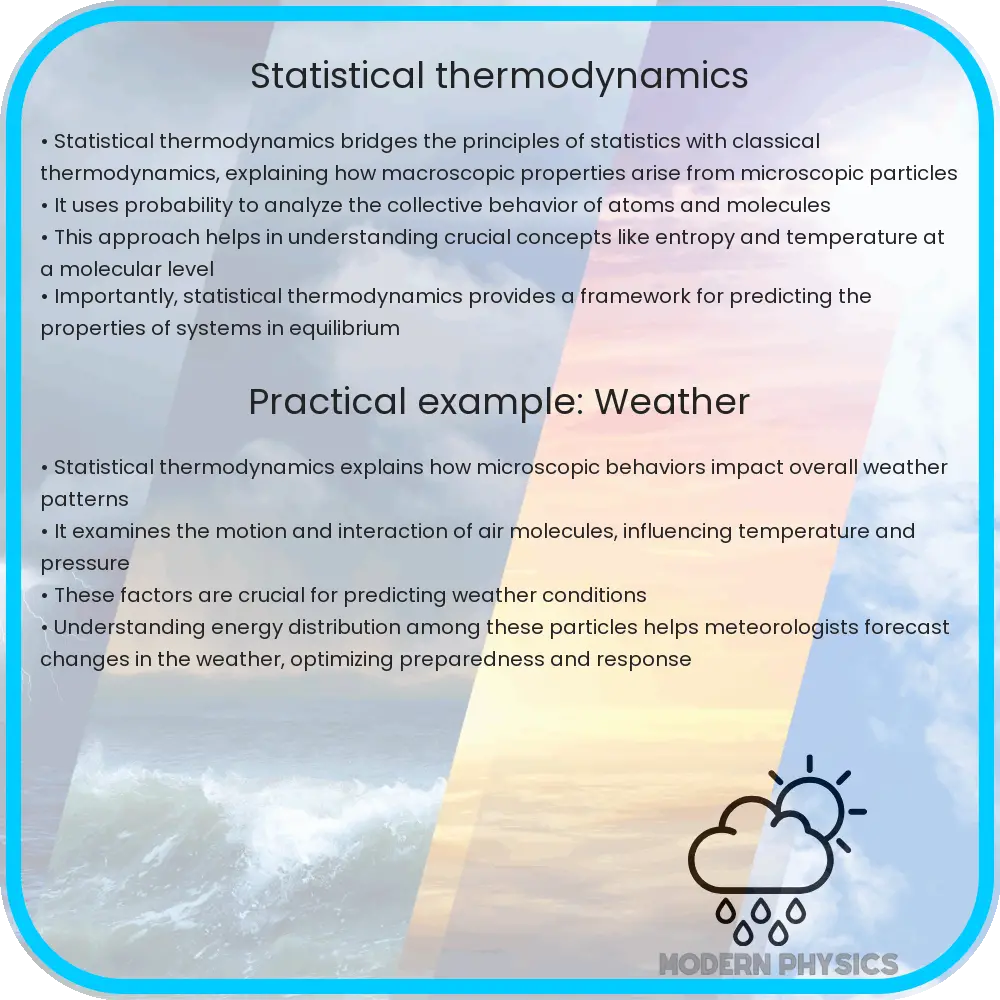Explore the fundamentals and applications of statistical thermodynamics, linking microscopic particle behavior to macroscopic properties.

Fundamentals of Statistical Thermodynamics
Statistical thermodynamics, a branch of physical chemistry, offers a microscopic perspective on how molecules and atoms interact in matter, bridging the gap between microscopic properties and macroscopic observations. This field is pivotal in understanding and predicting the thermodynamic behavior of systems based on the statistical behavior of its constituents.
Microstates and Macrostates
At the heart of statistical thermodynamics are the concepts of microstates and macrostates. A microstate represents a specific, microscopic configuration of a system’s particles, defined by positions and velocities. In contrast, a macrostate is characterized by macroscopic properties such as temperature, pressure, and volume. The number of microstates corresponding to a particular macrostate is crucial in determining the probability of the system being in that macrostate.
The Boltzmann Distribution
The Boltzmann distribution is a cornerstone of statistical thermodynamics. It describes the distribution of particles over various energy states in thermal equilibrium. It is expressed as:
\[ n_i = g_i \exp\left(-\frac{E_i}{k_BT}\right) \]
where \( n_i \) is the number of particles in the \(i^{th}\) energy state, \( g_i \) is the degeneracy of the state, \( E_i \) is the energy of the state, \( k_B \) is the Boltzmann constant, and \( T \) is the temperature in kelvins.
Applications in Chemical Reactions
Statistical thermodynamics plays a crucial role in understanding chemical reactions. By analyzing the distribution of molecular energies, it helps predict reaction rates and equilibria. This is particularly important in reactions that involve activation energy barriers, as it allows for the calculation of the fraction of molecules that possess sufficient energy to overcome these barriers.
In the next section, we will delve deeper into the applications of statistical thermodynamics in various fields, including material science and quantum chemistry, and explore advanced theories that further elucidate the behavior of complex systems.
Advanced Theories in Statistical Thermodynamics
Statistical thermodynamics extends into more complex systems through advanced theories. One such theory is Quantum Statistical Mechanics, which combines the principles of quantum mechanics with statistical thermodynamics. This approach is essential for understanding phenomena at very low temperatures where quantum effects become significant.
Another important theory is the Fermi-Dirac statistics, applicable to systems of fermions (particles like electrons, protons, and neutrons). It accounts for the Pauli exclusion principle, stating that no two fermions can occupy the same quantum state. Conversely, Bose-Einstein statistics apply to bosons (particles like photons and certain atomic nuclei), which can occupy the same quantum state, leading to phenomena like Bose-Einstein condensates.
Statistical Thermodynamics in Material Science
In material science, statistical thermodynamics aids in understanding and predicting the properties of materials. For instance, it helps in modeling phase transitions, such as from solid to liquid, by analyzing the energy distribution among particles. It also plays a vital role in semiconductor physics, where the distribution of electrons and holes at different energy levels determines the electrical properties of the material.
Quantum Chemistry and Statistical Thermodynamics
Quantum chemistry greatly benefits from statistical thermodynamics. It provides insights into molecular structures and reactions at the quantum level. For example, it assists in calculating molecular vibrational and rotational spectra, crucial for understanding molecular bonding and structure.
Conclusion
Statistical thermodynamics is a versatile and powerful tool in physical chemistry. It bridges the gap between the microscopic world of atoms and molecules and the macroscopic properties observed in bulk matter. Its principles and theories, from the Boltzmann distribution to Quantum Statistical Mechanics, play a crucial role in fields ranging from chemical reactions to material science and quantum chemistry. As science advances, the role of statistical thermodynamics in understanding and manipulating the material world will undoubtedly continue to grow, furthering our grasp of the universe’s fundamental processes.
